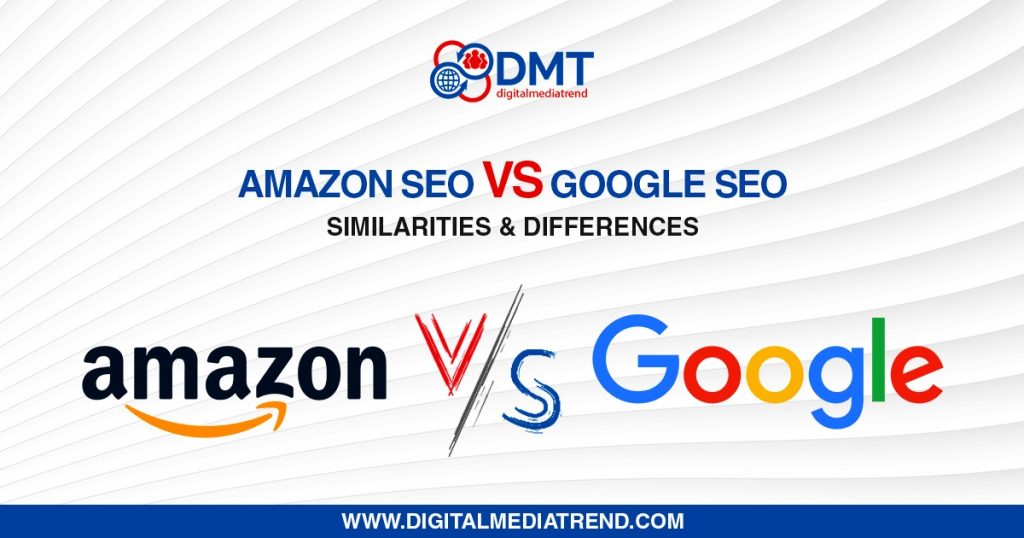It has always been a challenging situation for technical people whether they should focus on Amazon SEO or Website SEO. Speaking precisely, there is a lot of confusion about how these two strategies will be compared. And for some folks, almost everything about Amazon SEO is dizzying.
Facts about Amazon and Website’s search engine:

Website SEO aims to get you the higher ranking is search engines to make your proposed leads into sales. It improves overall visibility and the conversion rate. We have helped a huge number of clients and businesses in Pakistan to be on top ten results in google and other SERPs.
Amazon’s ranking algorithm is quite similar or close to Google’s search algorithm. It tends to analyze the relevant keyword search queries and matches the customer preferences with corresponding or desired products. Amazon works closely to find out relevant, informative, and trustworthy content to help its customers in every way possible.
It is evident that SEO, which works differently on Amazon than on Google. As a seller and an entrepreneur, it is worth knowing the main differences so that you can adapt your strategy to the platform.
Differences between Amazon SEO and Website SEO
1. Use of keywords
Amazon and Google have different procedures for using keywords.
Amazon places more emphasis on single words rather than keyword phrases, as Amazon users often have more specific queries. While keywords may come naturally when writing product copy, breaking them down into individual phrases does not limit your ability to rank for those search terms.
For example, if you target “espresso machine coffee machine”, Amazon will index your product even if you split this long phrase into separate phrases such as “coffee”, “machine” and “espresso machine”. In other words, Amazon does not object to you using “short keywords” and you only need to integrate them once for the A9 algorithm to index them.
As far as Website SEO is concerned, it is important to use long tail keywords because people often do all sorts of searches on its platform. A user may turn to Google to find out more about a product, then narrow down their search to “brands offering x product” and “buy x product” to make a purchase. If you want to cover both awareness-level and transactional searches, you need to include different keywords on your web pages, including long-tail keywords.
2. External links
One of the key aspects of Website SEO is link building. Google’s algorithm often tracks links to your pages on external sites. This allows it to assess the credibility of your website based on how trustworthy it is to other businesses. If you get a lot of valuable links from relevant, trustworthy sites, Google will consider your website an authority in its niche and boost your ranking so that more people can find your content.
Amazon, on the other hand, determines the credibility of a listing by how many people make purchases. Backlinks from other sites are not credited in any way. However, you can promote your listing on external websites, which can increase the number of searches, rankings and conversions on Amazon. Note that Amazon does not allow sellers to link to external pages from their listings.
In the latest A10 algorithm update, external traffic is now considered an influencing factor in ranking Amazon products. Product impressions and seller authority are among the main factors influencing search rankings, while internal advertising tools such as pay-per-click are given less importance.
3. Content and conversions
Certain types of content on Amazon play a crucial role in product rankings and subsequent sales. One such type of content is reviews. Listings with more reviews and higher star ratings often rank higher on Amazon because they are considered to influence a customer’s purchase decision. Potential buyers often scroll directly to reviews provided by previous buyers, so it’s important to earn great reviews if you want to improve your Amazon SEO.
Amazon also takes conversions into account when determining your search position. If your listings attract thousands of views but have a low conversion rate, this will have a negative impact on your Amazon position. Therefore, you need to optimize your listings for conversions, which includes writing great product copy, displaying high-quality product images, and pricing lower or more competitively than other sellers.
Google’s algorithm is more click-oriented than Amazon’s. To rank a page, Google takes into account SEO metrics such as click-through rate (CTR), bounce rate, user session duration and other key metrics. A high CTR and longer sessions mean that people consider your page to be relevant to their search queries.
A type of content that is particularly important to Google’s algorithm is information-oriented content. This can include recommendations, magazine articles and blogs, among others. Google wants to provide the most comprehensive results for all types of queries, so it ranks even high-level content that encourages a broader exploration and discovery phase. Google also makes sales, but this is not its main objective. Google’s main goal is to provide valuable results to its audience.
“Unlike Google, Amazon’s rankings are focused on conversions. The time a customer spends on your product page doesn’t matter that much, as long as they don’t end up buying the product. When it comes to ranking high in their rankings, their algorithm naturally focuses on the products that make the most money. This means that our goal when optimizing an Amazon listing should be singularly focused on conversion. We have to convince the customer to shop during that visit, whether it’s 30 seconds or 5 minutes.”
Amazon SEO vs. Website SEO: Executive Summary
In conclusion, optimizing for Amazon and Google involves a different mindset. Both search engines play an invaluable role in the buyer’s journey, but Amazon’s algorithm is based on meeting the needs of buyers and displaying the products that are most likely to sell.

